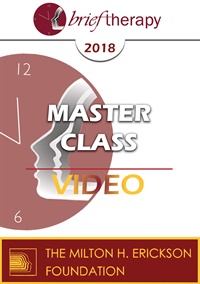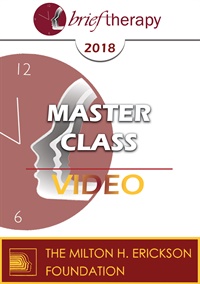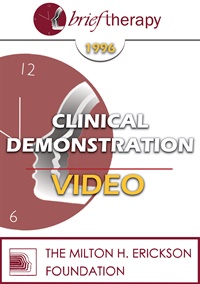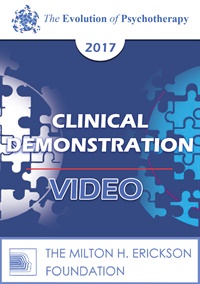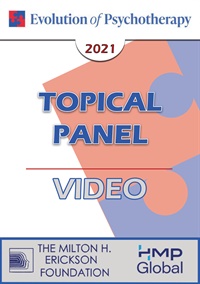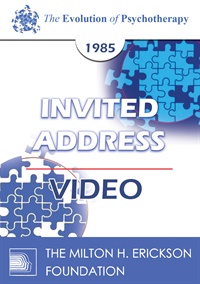
- Average Rating:
- Not yet rated
- Topic Areas:
- Experiential Therapy | Clinical Demonstrations | Phobia | Psychotherapy | Therapist Development | Art and Creativity | Ericksonian Psychotherapy | Art of Psychotherapy
- Bundle(s):
- Art of Psychotherapy - Experiential Series
- Categories:
- Art of Psychotherapy
- Faculty:
- Jeffrey Zeig, PhD
- Course Levels:
- Master Degree or Higher in Health-Related Field
- Duration:
- 2 Hours 5 Minutes
- Format:
- Audio and Video
- Original Program Date:
- May 17, 2020
- Short Description:
- The presenting problem for Class 1 is fear.
- Price:
- $79.00 - Base Price
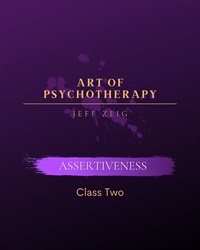
- Average Rating:
- Not yet rated
- Topic Areas:
- Clinical Demonstrations | Experiential Therapy | Psychotherapy | Therapist Development | Art and Creativity | Ericksonian Psychotherapy | Art of Psychotherapy
- Bundle(s):
- Art of Psychotherapy - Experiential Series
- Categories:
- Art of Psychotherapy
- Faculty:
- Jeffrey Zeig, PhD
- Course Levels:
- Master Degree or Higher in Health-Related Field
- Duration:
- 2 Hours 25 Minutes
- Format:
- Audio and Video
- Original Program Date:
- May 24, 2020
- Short Description:
- Our demonstration subject for Class 2 is a psychiatrist who would like to become a better leader.
- Price:
- $79.00 - Base Price
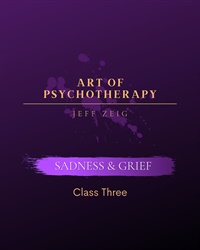
- Average Rating:
- Not yet rated
- Topic Areas:
- Clinical Demonstrations | Experiential Therapy | Grief | Psychotherapy | Therapist Development | Art and Creativity | Ericksonian Psychotherapy | Art of Psychotherapy
- Bundle(s):
- Art of Psychotherapy - Experiential Series
- Categories:
- Art of Psychotherapy
- Faculty:
- Jeffrey Zeig, PhD
- Course Levels:
- Master Degree or Higher in Health-Related Field
- Duration:
- 2 hours 22 minutes
- Format:
- Audio and Video
- Original Program Date:
- May 31, 2020
- Short Description:
- The presenting problem for Class 3 is an issue with expressing sadness and grief.
- Price:
- $79.00 - Base Price
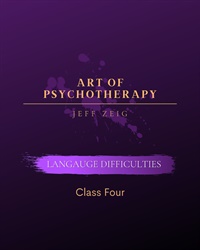
- Average Rating:
- Not yet rated
- Topic Areas:
- Clinical Demonstrations | Experiential Therapy | Psychotherapy | Therapist Development | Art and Creativity | Ericksonian Psychotherapy | Art of Psychotherapy
- Bundle(s):
- Art of Psychotherapy - Experiential Series
- Categories:
- Art of Psychotherapy
- Faculty:
- Jeffrey Zeig, PhD
- Course Levels:
- Master Degree or Higher in Health-Related Field
- Duration:
- 2 Hours 15 Minutes
- Format:
- Audio and Video
- Original Program Date:
- Jun 07, 2020
- Short Description:
- In our final class of this series, our demonstration subject has an impediment in learning the German language.
- Price:
- $79.00 - Base Price
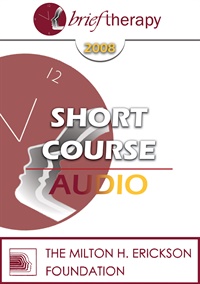
- Average Rating:
- Not yet rated
- Topic Areas:
- Short Courses | Children and Adolescent Therapy | Ericksonian Psychotherapy | Divorce | Psychotherapy | Ericksonian Hypnosis and Therapy Techniques
- Categories:
- Brief Therapy Conference | Brief Therapy Conference 2008
- Faculty:
- Maria Escalante de Smith, MA
- Duration:
- 1:25:05
- Format:
- Audio Only
- Original Program Date:
- Dec 11, 2008
- Short Description:
- Ericksonian psychotherapy emphasizes the utilization of people's resources. When working with children of divorced parents, I focus on strengths and keep in mind the Ericksonian interventions should be brief because children may get tired of being in therapy for a long time. In a case with two children, techniques including the use of toys will be discussed. How to make several brief interventions quickly while utilizing "toy co-therapists" in home assignments, and the combination of conversational trance with tasks will be emphasized. There also will be references to the importance of working with the family system.
- Price:
- $15.00 - Base Price
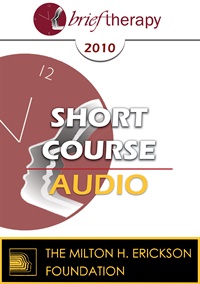
- Average Rating:
- Not yet rated
- Topic Areas:
- Psychotherapy | Short Courses | Ericksonian Psychotherapy | Ericksonian Hypnosis and Therapy Techniques
- Categories:
- Brief Therapy Conference | Brief Therapy Conference 2010
- Faculty:
- Maria Escalante de Smith, MA
- Duration:
- 1:27:11
- Format:
- Audio Only
- Original Program Date:
- Dec 09, 2010
- Short Description:
- Women who face unplanned pregnancies may experience a wide range of emotions and go through deep crises when they learn they are pregnant. In this workshop, the presenter will describe how brief Ericksonian interventions can help them explore possibilities and cope with their crises during unplanned pregnancy. Examples of quick interventions and conversational trance will be given as well. There will be references to the importance of hope and exercises for coming to terms with previous experience.
- Price:
- $15.00 - Base Price
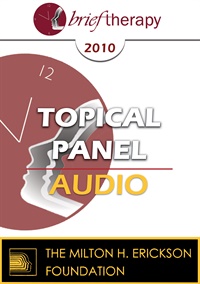
- Average Rating:
- Not yet rated
- Topic Areas:
- Milton Erickson | Topical Panels | Ericksonian Hypnosis and Therapy Techniques | Ericksonian Psychotherapy | History of Psychotherapy
- Categories:
- Brief Therapy Conference | Brief Therapy Conference 2010
- Faculty:
- Steve Andreas, MA, NLP | Stephen Gilligan, PhD | Bill O'Hanlon, MS | Jeffrey Zeig, PhD
- Duration:
- 58:29
- Format:
- Audio Only
- Original Program Date:
- Dec 11, 2010
- Short Description:
- This topical panel paints a rich, multi-angled portrait of Milton Erickson through personal stories, clinical memories, and lived encounters. Panelists reflect on his use of confusion, implication, humor, and nonverbal attunement, while exploring the humility, curiosity, and generosity that shaped both his work and his enduring influence on psychotherapy.
- Price:
- $15.00 - Base Price
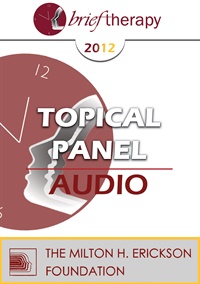
- Average Rating:
- Not yet rated
- Topic Areas:
- Milton Erickson | Topical Panels | Ericksonian Hypnosis and Therapy Techniques | Ericksonian Psychotherapy | History of Psychotherapy
- Categories:
- Brief Therapy Conference | Brief Therapy Conference 2012
- Faculty:
- Steve Andreas, MA, NLP | Robert Dilts, BA | Bill O'Hanlon, MS | Roxanna Erickson Klein, RN, PhD, LPC, LCDC
- Duration:
- 1:01:54
- Format:
- Audio Only
- Original Program Date:
- Dec 07, 2012
- Short Description:
- This topical panel offers a vivid, personal portrait of Milton Erickson through stories, reflections, and lived encounters. Panelists explore the qualities that shaped his influence, including curiosity, playfulness, generosity, and deep observational skill, while tracing how his spirit of experimentation and respect for human potential continues to ripple through psychotherapy today.
- Price:
- $15.00 - Base Price

- Average Rating:
- Not yet rated
- Topic Areas:
- Workshops | Clinical Process | Ericksonian Psychotherapy
- Categories:
- Brief Therapy Conference | Brief Therapy Conference 2012
- Faculty:
- Steve Andreas, MA, NLP
- Duration:
- 2:43:40
- Format:
- Audio Only
- Original Program Date:
- Dec 08, 2012
- Short Description:
- This extended workshop trains clinicians to notice and use subtle perceptual cues that guide moment-to-moment change. Through demonstrations and practice, it shows how posture, eye gaze, gesture, voice tone, and curiosity can shift emotional states, deepen rapport, and create movement with anxiety, trauma, grief, and stuck patterns, often without heavy verbal processing.
- Price:
- $15.00 - Base Price
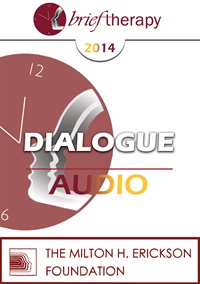
- Average Rating:
- Not yet rated
- Topic Areas:
- Dialogues | Experiential Therapy | Brief Therapy | Psychotherapy | Ericksonian Psychotherapy
- Categories:
- Brief Therapy Conference | Brief Therapy Conference 2014
- Faculty:
- Jeffrey Zeig, PhD | Steve Andreas, MA, NLP
- Duration:
- 1:00:36
- Format:
- Audio Only
- Original Program Date:
- Dec 13, 2014
- Short Description:
- This dialogue explores implication as a central force in therapeutic communication, drawing from Ericksonian hypnosis, social psychology, and everyday interaction. Through stories, demonstrations, and debate, the conversation shows how meaning is carried through tone, gesture, context, and suggestion, and how working at this implicit level can mobilize responsiveness, bypass resistance, and deepen clinical impact
- Price:
- $15.00 - Base Price
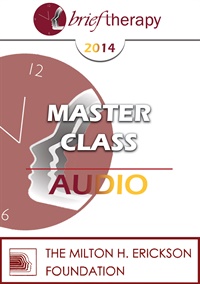
- Average Rating:
- Not yet rated
- Topic Areas:
- Ericksonian Psychotherapy | Master Classes | Brief Therapy | Ericksonian Hypnosis and Therapy Techniques | Experiential Therapy | Psychotherapy | Solution Oriented Approach
- Categories:
- Brief Therapy Conference | Brief Therapy Conference 2014 | Master Class
- Faculty:
- Jeffrey Zeig, PhD | Bill O'Hanlon, MS
- Duration:
- 5:51:06
- Format:
- Audio Only
- Original Program Date:
- Dec 15, 2014
- Short Description:
- Many schools of psychotherapy have been derived from the seminal work of Milton H Erickson M.D., including strategic therapy, interactional therapy, NLP and solution focused therapy. In some approaches hypnosis is central; in other approaches hypnosis is more peripheral. This class features two experts personally trained by Dr. Erickson, each of whom approach psychotherapy from somewhat different perspectives. In his approach, Possibility Therapy, Bill O'Hanlon epitomizes the strengths of a solution focused orientation. In his experiential approach, Jeffrey Zeig shades treatment in the direction of developing dramatic reference experiences.
- Price:
- $15.00 - Base Price

- Average Rating:
- Not yet rated
- Topic Areas:
- Ericksonian Psychotherapy | Psychotherapy | Trauma | Short Courses | Children and Adolescent Therapy | Pain and Healing | Brief Therapy | Ericksonian Hypnosis and Therapy Techniques
- Categories:
- Brief Therapy Conference | Brief Therapy Conference 2014
- Faculty:
- Maria Escalante de Smith, MA
- Duration:
- 1:09:29
- Format:
- Audio Only
- Original Program Date:
- Dec 11, 2014
- Short Description:
- When children experience painful emotions and anxiety after going through traumatic events they may not be able to understand what is happening to them and thus get depressed. Other consequences may appear, like lack of concentration or academic problems. Attendants will learn how treat these conditions by using brief Ericksonian techniques, assignments, and toys and by including the family members during therapy.
- Price:
- $15.00 - Base Price
- Average Rating:
- Not yet rated
- Topic Areas:
- Master Classes | Hypnosis | Psychotherapy | Ericksonian Hypnosis and Therapy Techniques | Strategic Therapy | Ericksonian Psychotherapy | Experiential Therapy | Hypnotherapy
- Categories:
- Brief Therapy Conference | Brief Therapy Conference 2018
- Faculty:
- Michael Yapko, PhD | Jeffrey Zeig, PhD
- Course Levels:
- Master Degree or Higher in Health-Related Field
- Duration:
- 2:56:13
- Format:
- Audio and Video
- Original Program Date:
- Dec 10, 2018
- Short Description:
- In this interactive master class, live demonstrations show how hypnosis and experiential methods can help clients transform fear into resilience. One volunteer confronts a lifelong fear of deep water, discovering a powerful inner resource through imagery of her father’s love. Another works through the emotional aftermath of divorce, learning new ways to disarm old patterns of intimidation. The session highlights how metaphor, experiential sculpting, and hypnotic reframing can unlock unexpected pathways to strength and healing.
- Price:
-
Sale is $29.00
price reduced from Base Price - $59.00
- Average Rating:
- Not yet rated
- Topic Areas:
- Master Classes | Hypnosis | Psychotherapy | Ericksonian Hypnosis and Therapy Techniques | Ericksonian Psychotherapy | Experiential Therapy | Hypnotherapy
- Categories:
- Brief Therapy Conference | Brief Therapy Conference 2018
- Faculty:
- Michael Yapko, PhD | Jeffrey Zeig, PhD
- Course Levels:
- Master Degree or Higher in Health-Related Field
- Duration:
- 2:43:33
- Format:
- Audio and Video
- Original Program Date:
- Dec 10, 2018
- Short Description:
- This session explores how hypnosis and strategic therapy can help clients untangle patterns of avoidance, self-doubt, and family tension. By using affective dissociation, metaphors, and experiential learning, the master class demonstrates how to separate mood from action, strengthen integrity with self, and foster resilience. Participants gain insight into how language, stories, and relational dynamics can be woven into therapy to create lasting change.
- Price:
-
Sale is $29.00
price reduced from Base Price - $59.00
- Average Rating:
- Not yet rated
- Topic Areas:
- Clinical Demonstrations | Ericksonian Psychotherapy | Psychotherapy | Brief Therapy
- Categories:
- Brief Therapy Conference | Brief Therapy Conference 1996
- Faculty:
- Jeffrey Zeig, PhD
- Course Levels:
- Master Degree or Higher in Health-Related Field
- Duration:
- 59:09
- Format:
- Audio and Video
- Original Program Date:
- Dec 13, 1996
- Short Description:
- BT96 Clinical Demonstration 01 - Brief Ericksonian Psychotherapy - Jeffrey Zeig, PhD
- Price:
-
Sale is $29.00
price reduced from Base Price - $59.00

- Average Rating:
- Not yet rated
- Topic Areas:
- Ericksonian Psychotherapy | Psychotherapy | Invited Addresses | Neurobiology | Neuroscience
- Categories:
- Evolution of Psychotherapy | Evolution of Psychotherapy 2000
- Faculty:
- Ernest Rossi, PhD | Thomas Szasz, MD
- Duration:
- 1 Hour 25 Minutes
- Format:
- Audio Only
- Original Program Date:
- May 28, 2000
- Short Description:
- Current research on neurogenesis (growth of new brain cells) indicates that novelty, environmental enrichment and physical exercise can facilitate new growth in the adult human brain. How can we optimize our Ericksonian approaches to support the psychobiological growth process?
- Price:
- $15.00 - Base Price
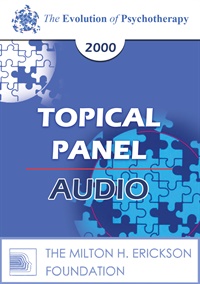
- Average Rating:
- Not yet rated
- Topic Areas:
- Topical Panels | Milton Erickson | Ericksonian Hypnosis and Therapy Techniques | Ericksonian Psychotherapy
- Categories:
- Evolution of Psychotherapy | Evolution of Psychotherapy 2000 | Pioneers in Couples and Family Therapy
- Faculty:
- Jay Haley, MA | Ernest Rossi, PhD | Paul Watzlawick, PhD | Jeffrey Zeig, PhD
- Duration:
- 54 Minutes
- Format:
- Audio Only
- Original Program Date:
- May 28, 2000
- Short Description:
- Milton H. Erickson’s innovative psychotherapy methods take center stage, including his directive style, interactive techniques, and deep attunement to patients’ language and experience. Panelists discuss his use of humor, detailed session planning, and belief in the patient’s capacity for self-directed change, emphasizing the lasting impact of his personalized approach. Moderated by Camillo Loriedo, MD.
- Price:
- $15.00 - Base Price
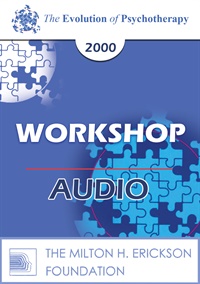
- Average Rating:
- Not yet rated
- Topic Areas:
- Ericksonian Psychotherapy | Neuroscience | Workshops | Ericksonian Hypnosis and Therapy Techniques | Psychotherapy
- Categories:
- Evolution of Psychotherapy | Evolution of Psychotherapy 2000
- Faculty:
- Ernest Rossi, PhD
- Duration:
- 2 Hours 33 Minutes
- Format:
- Audio Only
- Original Program Date:
- May 25, 2000
- Short Description:
- Neuroscientists have proposed that the next ten years be devoted to exploring cognitive approaches to facilitating neurogenesis in the hippocampus of the adult human brain. Let's do it!
- Price:
- $15.00 - Base Price
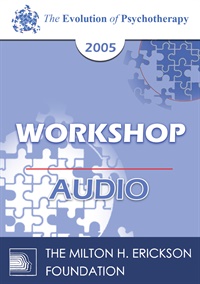
- Average Rating:
- Not yet rated
- Topic Areas:
- Workshops | Ericksonian Hypnosis and Therapy Techniques | Hypnosis | Arm Levitation | Psychotherapy | Ericksonian Psychotherapy | Neuroscience | Hypnotic Phenomena
- Categories:
- Evolution of Psychotherapy | Evolution of Psychotherapy 2005
- Faculty:
- Ernest Rossi, PhD
- Duration:
- 2 Hours 12 Minutes
- Format:
- Audio Only
- Original Program Date:
- Dec 07, 2005
- Short Description:
- Erickson's hand levitation and pantomime techniques have evolved into simple, easy to learn, activity-dependent approaches to therapeutic hypnosis, and are consistent with the theory and research of the current neuroscience on brain plasticity and the molecular genomic level of psychotherapy. Demonstrations with volunteers from the audience will illustrate.
- Price:
- $15.00 - Base Price

- Average Rating:
- Not yet rated
- Topic Areas:
- Psychotherapy | Workshops | Generative Psychotherapy | Ericksonian Psychotherapy | Self-Relations | Resources
- Categories:
- Evolution of Psychotherapy | Evolution of Psychotherapy 2013
- Faculty:
- Stephen Gilligan, PhD
- Duration:
- 2 Hours 42 Minutes
- Format:
- Audio Only
- Original Program Date:
- Dec 14, 2013
- Short Description:
- This workshop presents the Ericksonian and Self-Relations Psychotherapy approach to human states of suffering: depression, anxiety, trauma, addiction, etc. This practical and positive approach assumes that each core human experience has equivalent potential to be positive or negative, depending on the human relationship to it; and thus focuses on how problems can be transformed into resources by skillful human connection. This process operates at two levels: (1) developing a generative state (in the therapist, client, and relationship field) and then (2) using specific methods of transforming negative experiences and behaviors.
- Price:
- $15.00 - Base Price
Credit available - Click Here for more information
- Average Rating:
- Not yet rated
- Topic Areas:
- Clinical Demonstrations with Discussant | Psychotherapy | Evocative Communication | Brief Therapy | Ericksonian Psychotherapy | Ericksonian Hypnosis and Therapy Techniques | Experiential Therapy | Strategic Therapy
- Bundle(s):
- Learning Track - EP17 Erickson Stream
- Categories:
- Evolution of Psychotherapy | Evolution of Psychotherapy 2017 | Evolution of Psychotherapy Erickson Learning Track | Online Continuing Education
- Faculty:
- Jeffrey Zeig, PhD | Otto Kernberg, MD
- Course Levels:
- Master Degree or Higher in Health-Related Field
- Duration:
- 1:24:21
- Format:
- Audio and Video
- Original Program Date:
- Dec 14, 2017
- Short Description:
- Experiential components central to brief, strategic approaches to psychotherapy. We will compare and contrast Ericksonian and psychodynamic perspectives.
- Price:
-
Sale is $29.00
price reduced from Base Price - $59.00
- Average Rating:
- Not yet rated
- Topic Areas:
- Topical Panels | Depression | Ericksonian Psychotherapy | Gestalt | Hypnosis
- Categories:
- Evolution of Psychotherapy | Evolution of Psychotherapy 2021
- Faculty:
- Michael Yapko, PhD | Michael Miller | Jeffrey Zeig, PhD
- Course Levels:
- Master Degree or Higher in Health-Related Field
- Duration:
- 1 hour
- Format:
- Audio and Video
- Original Program Date:
- Dec 02, 2021
- Short Description:
- This session explores depression as both a personal experience and a social phenomenon. The discussion examines how loss, disconnection, and learned helplessness shape depressive states, and how action, contact, and perspective can restore vitality. Participants gain practical insights into prevention, hypnosis, and skill-building strategies that promote resilience and renewed engagement with life
- Price:
- $59.00 - Base Price
- Average Rating:
- Not yet rated
- Topic Areas:
- Invited Addresses | Ericksonian Psychotherapy | Psychotherapy | Ericksonian Hypnosis and Therapy Techniques
- Categories:
- Evolution of Psychotherapy | Evolution of Psychotherapy 1985
- Faculty:
- Jeffrey Zeig, PhD
- Course Levels:
- Master Degree or Higher in Health-Related Field
- Duration:
- 1:30:14
- Format:
- Audio and Video
- Original Program Date:
- Dec 11, 1985
- Short Description:
- Educational Objectives: To list five attitudes of influence To describe the efficacy of using social influence to elicit human potential
- Price:
-
Sale is $29.00
price reduced from Base Price - $59.00
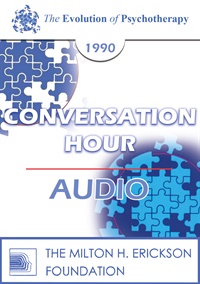
- Average Rating:
- Not yet rated
- Topic Areas:
- Conversation Hours | Psychotherapy | Case Discussions | Ericksonian Psychotherapy | Managed Care
- Categories:
- Evolution of Psychotherapy | Evolution of Psychotherapy 1990 | Pioneers in Couples and Family Therapy
- Faculty:
- Jay Haley, MA
- Duration:
- 1 Hour 1 Minutes
- Format:
- Audio Only
- Original Program Date:
- Dec 12, 1990
- Short Description:
- This session deals with the impact of managed care on therapy, the evolution of family therapy, and the need for adaptability in changing institutional and social contexts. Haley covers the influence of key theorists, the importance of structured planning, and the ethical balance of power and family involvement. Additional topics include single-session therapy and treating severely abused children.
- Price:
- $15.00 - Base Price
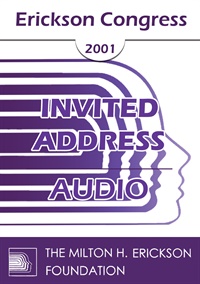
- Average Rating:
- Not yet rated
- Topic Areas:
- Invited Addresses | Ericksonian Psychotherapy | Meditation, Spirituality and Yoga | Psychotherapy
- Categories:
- Erickson Congress 2001 | Erickson Congress
- Faculty:
- Carl Hammerschlag, MD
- Duration:
- 57:51
- Format:
- Audio Only
- Original Program Date:
- Dec 09, 2001
- Short Description:
- IC01 Invited Address - Ericksonian Psychotherapy and Shamanic Healing - Carl Hammerschlag, MD The power to manipulate words and environments is a healing ceremony that moves patients beyond their limitations. Ericksonian psychotherapists and shamans understand that the process of change is an inner journey whose only prerequesite is a willingness to look within. Using words, stories, imaginary beings, rituals and ordeals, healers help patients illuminate the unconscious allowing them to create new ending to old stories.
- Price:
- $15.00 - Base Price


